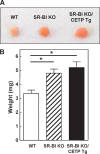Scavenger receptor class B type I-mediated uptake of serum cholesterol is essential for optimal adrenal glucocorticoid production
- PMID: 19179307
- PMCID: PMC2681386
- DOI: 10.1194/jlr.M800410-JLR200
Scavenger receptor class B type I-mediated uptake of serum cholesterol is essential for optimal adrenal glucocorticoid production
Abstract
Impaired scavenger receptor class B type I (SR-BI)-mediated uptake of HDL-cholesterol esters (HDL-CE) induces adrenal insufficiency in mice. Humans contain an alternative route of HDL-CE clearance, namely through the transfer by cholesteryl ester transfer protein (CETP) to apolipoprotein B lipoproteins for subsequent uptake via the LDL receptor. In this study, we determined whether CETP can compensate for loss of adrenal SR-BI. Transgenic expression of human CETP (CETP Tg) in SR-BI knockout (KO) mice increased adrenal HDL-CE clearance from 33-58% of the control value. SR-BI KO/CETP Tg and SR-BI KO mice displayed adrenal hypertrophy due to equally high plasma adrenocorticotropic hormone levels. Adrenal cholesterol levels and plasma corticosterone levels were 38-52% decreased in SR-BI KO mice with and without CETP expression. SR-BI KO/CETP Tg mice also failed to increase their corticosterone level after lipopolysaccharide challenge, leading to an identical >4-fold increased tumor necrosis factor-alpha response compared with controls. These data indicate that uptake of CE via other routes than SR-BI is not sufficient to generate the cholesterol pool needed for optimal adrenal steroidogenesis. In conclusion, we have shown that CETP-mediated transfer of HDL-CE is not able to reverse adrenal insufficiency in SR-BI knockout mice. Thus, SR-BI-mediated uptake of serum cholesterol is essential for optimal adrenal function.
Figures






References
-
- Van Eck M., M. Pennings, M. Hoekstra, R. Out, and T. J. Van Berkel. 2005. Scavenger receptor BI and ATP-binding cassette transporter A1 in reverse cholesterol transport and atherosclerosis. Curr. Opin. Lipidol. 16 307–315. - PubMed
-
- Lewis G. F., and D. J. Rader. 2005. New insights into the regulation of HDL metabolism and reverse cholesterol transport. Circ. Res. 96 1221–1232. - PubMed
-
- Acton S., A. Rigotti, K. T. Landschulz, S. Xu, H. H. Hobbs, and M. Krieger. 1996. Identification of scavenger receptor SR-BI as a high density lipoprotein receptor. Science. 271 518–520. - PubMed
-
- Out R., M. Hoekstra, J. A. Spijkers, J. K. Kruijt, M. Van Eck, I. S. Bos, J. Twisk, and T. J. Van Berkel. 2004. Scavenger receptor class B type I is solely responsible for the selective uptake of cholesteryl esters from HDL by the liver and the adrenals in mice. J. Lipid Res. 45 2088–2095. - PubMed
-
- Hoekstra M., I. Meurs, M. Koenders, R. Out, R. B. Hildebrand, J. K. Kruijt, M. Van Eck, and T. J. Van Berkel. 2008. Absence of HDL cholesterol ester uptake in mice via SR-BI impairs an adequate adrenal glucocorticoid-mediated stress response to fasting. J. Lipid Res. 49 738–745. - PubMed
Publication types
MeSH terms
Substances
LinkOut - more resources
Full Text Sources
Medical
Molecular Biology Databases
Research Materials
Miscellaneous

